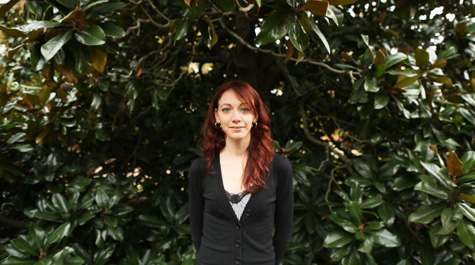Grad student Alex Finley found her roots — and more
This is part one of a two-story series. Check back Nov. 26 for the second part. - Ed.
As a child, Alex Finley remembers going through three phases of intense interest: One was genealogy. Another was the Civil War. The third was American Girls dolls.
“So I guess I was always destined to be a historian,” she said with a chuckle.
Finley, a Ph.D. candidate in history at William & Mary who is studying the domestic slave trade and the finance and business practices of slave traders in the antebellum period, combined two of those three passions to uncover a little known, controversial community in West Virginia.
It’s a discovery that has drawn the attention of television producers from the PBS program Finding Your Roots and ushered in a fascinating chapter in her life.
She began by researching her mother’s family history while she was in high school in southern Ohio, and continued her research as an undergraduate at Ohio State, completing an honors thesis on that particular branch of the family.
The Male family – or Mayle, as it’s also known – came to the United States from Dover, England, and eventually settled in Hampshire County, located in West Virginia’s Eastern Panhandle and Potomac Highlands regions.
Wilmore Male and his wife, Mary, had several children, including Wilmore, Jr., who fought in the Revolutionary War and came back to West Virginia to start a farm.
While there, he began a relationship with a slave he owned named Nancy.
“The proof we have of this is an extraordinary emancipation document from 1826,” Finley said. “(Male) emancipates Nancy and says that she is forever set free from this point – on the condition that she remain living with him as his wife.
“That’s extraordinary for the time period, for several reasons: One, he’s coming out publicly and saying this. Two, interracial marriage is illegal at this time and here he is in a courthouse saying he intends to live with this woman. They end up living together, with no evidence they were ever harassed or bothered by anyone for their relationship.”
How could that be? Finley’s research showed that the man at the courthouse who recorded the document – John White -- was the son of Male’s captain in the Revolutionary War.
“I got the sense that there was some kind of friendship there,” Finley said. “Maybe he protected Wilmer and Nancy to a certain extent.”
Wilmer and Nancy had several children together. Eventually, some of them migrated to an area just outside of Philippi called Chestnut Ridge. Along with a couple of other multi-racial families, they formed what Finley called a “safe-space” community where they could live mostly unbothered by outsiders.
“It was a fairly unique community, but there were a number of similar multi-racial groups that attracted attention from anthropologists in the 20th century,” Finley said. “They have very bizarre names, like The Red Bones, the Melungeons, for example. The people in Chestnut Ridge were originally called Guineas, which of course is derogatory.”
A member of the Male clan wound up marrying a man named William Harris, who is Finley’s great grandfather four times removed.
“I slowly worked until I got to my grandpa’s family – they’d always been the most mysterious folks -- and that’s how I found Wilmer and Nancy,” Finley said.
As a historian, Finley said she’s thrilled that so many people are involved in genealogical searches.
“I love for people to be interested in the past,” she said. “A lot of times it’s hard to get people excited about something that happened 100, 200 years ago. But if you can look back and say ‘One of my relatives fought in the Revolutionary War,’ or ‘One of my relatives immigrated through Ellis Island,’ then that’s a personal connection you have with the past – and that’s a very personal motive to learn about our shared past.”
Her initial foray into genealogy had much to do with learning more about herself and why she had the interests and values she held.
“A lot of times we take for granted that we were just born into the situations we were born into, but if you really think about everything that had to happen for you to be where you are now, all the things that are totally beyond your control that influenced the opportunities you’re born with and the position you’re born into, that all has to do with who your ancestors were and how they got to be where they are today,” she said. “For example, if my relatives hadn’t migrated to West Virginia -- and stayed ... People want to learn about themselves, learn about their family traditions.”
Given her background, it’s no surprise that one of Finley’s favorite television programs is “Finding Your Roots." And for good reason. Finley will make an appearance on the Nov. 25 episode, airing at 8 p.m.
You’ll want to watch. You'll be stunned by what Finley discovers about her past. Then check back here on Nov. 26 for part two of the story. - Ed.
 Skip to main content
Skip to main content

